Your Call?
Which of today’s four featured shorebird images do you like best? Why?
My Call
In the last blog post, my clear favorite was image #3: Atlantic Puffin in flight in high wind with sandeels for chicks– TIGHT! Most folks agreed 🙂
Elinor Osborn/August 1, 2023 at 7:35am
#3 with the unique, creative crop is my pick. Another learning experience for me. I don’t think of trying crops often enough.
elle/August 1, 2023 at 10:02am
Though all images are great (of course!), number three is my favorite. It is intimate, with great detail. I like the gesture of the sandeel that is curving over the beak. The negative space is just right.
David Pugsley/August 1, 2023 at 10:15am
Harsh conditions, but a dream situation none the less! The OOTB crop takes it for me. If I were to pick something more traditional I’d lean towards #4.
David Policansky/August 1, 2023 at 5:23pm
Image #3 for sure, only in part because of the fish! It’s wonderful.
Ted Willcox/August 1, 2023 at 12:59pm
Image #3 for me. It is so out of the ordinary, and so sharp, and so interesting. What more can I say!
Anthony Ardito/August 1, 2023 at 9:52pm
#3 — TIGHT is RIGHT!
The Fact$ of Life
The market for editorial sales of natural history images has virtually disappeared. The incomes of the world’s top stock photographers are down by at least 90%. Like me, many depend on income from photo trips, the sale of educational materials, and income from this or that affiliate program.
In 2001, BAA sold the publication rights to images for nearly one-quarter million US dollars. That amount dropped to about $20,000 by 2011, and in 2017, to slightly more than $2,000.00. We’ve stopped counting. IPTs used to fill within days. Now I am happy to go with one or two folks, but I’d much rather have you along. And so it goes. Do consider joining an IPT. In 2009, I turned to creating educational blog posts, now to the tune of 4063! Yes, 4063 educational blog posts. Please, therefore, remember to use either my B&H or Bedfords affiliate links for your major purposes. It will not cost you one cent to do either.
What’s Up?
On Monday, after taking the ferry back to the mainland, we overnighted at a very nice hotel in Akureyri and enjoyed a late but great farewell dinner. We left at 8am the next day for the leisurely drive back to Reykjavik and arrived at 3:00pm. Anita North kindly rented a car for the four of us, Anita, Greg, Bruce, and I. We headed back to the Red-throated Loon spot. Greg kindly drove. Things began very slowly with just two loons in the lake so I laid down for a short nap in the soft marsh grass. At 7:15, things heated up. We enjoyed virtually non-stop flight, courtship, and territorial disputes action for close to two hours. Photos and additional details soon. I can tell you that my left shoulder and left elbow are hurting from handholding the 600mm f/4 GM lens with the 1.4X TC attached. I did not get to bed until nearly midnight, woke at 5:45am, 15 minutes before the alarm went off, and transferred to Keflavik Airport for my 10:00am flight to Boston. I did get a nice nap on the plane. I finished this blog post at Logan Airport. After a 4-hour layover, I will board my flight to Orlando where Jim will pick me up at about 7:30 or so. I should be home at about 9:30pm.
Door to door travel: 18 1/2 hours. It was a great trip and well worth the effort.
If you would like info on Greg Downing’s 2024 and/or the 2025 Grimsey Island puffin trips, please shoot me an e-mail by clicking here.
Today is Thursday 3 August. I am looking forward to getting back in the pool. I am not looking forward to the jet lag.
Wherever you are and whatever you are doing, I hope that you too have a great day.
Please remember to use the B&H and Amazon links that are found on most blog pages and to use the BIRDSASART discount code at checkout when purchasing your new gear from Bedfords to get 3% back on your credit card and enjoy free second-day air FedEx. Please, also, consider joining a BAA IPT. You will be amazed at how much you will learn!
You can find some great photo accessories (and necessities, like surf booties!) on Amazon by clicking on the Stuff tab on the orange/yellow menu bar above. On a related note, it would be extremely helpful if blog-folks who, like me, spend too much money on Amazon, would get in the habit of clicking on the Amazon logo link on the right side of each blog post when they shop online. As you might expect, doing so will not cost you a single penny, but would be appreciated tremendously by yours truly. And doing so works seamlessly with your Amazon Prime account.
If an item — a Delkin flash card, or a tripod head — for example, that is available from B&H and/or Bedfords, is also available in the BAA Online Store, it would be great, and greatly appreciated, if you would opt to purchase from us. We will match any price. Please remember also to use my B&H affiliate links or to earn 3% cash back at Bedfords by using the BIRDSASART discount code at checkout for your major gear purchases. Doing either often earns you free guides and/or discounts. And always earns my great appreciation.
The Fact$ of Life
The market for editorial sales of natural history images has virtually disappeared. The incomes of the world’s top stock photographers are down by at least 90%. Like me, many depend on income from photo trips, the sale of educational materials, and income from this or that affiliate program.
In 2001, BAA sold the publication rights to images for nearly one-quarter million US dollars. That amount dropped to about $20,000 by 2011, and in 2017, to slightly more than $2,000.00. We’ve stopped counting. IPTs used to fill within days. Now I am happy to go with one or two folks, but I’d much rather have you along. And so it goes. In 2009, I turned to creating educational blog posts, now to the tune of 4063! Yes, 4063 educational blog posts. Please, therefore, remember to use either my B&H or Bedfords affiliate links for your major purposes. It will not cost you one cent to do either.
B&H
Many folks have written recently stating that they purchased a Sony a1 from B&H and would like their free membership in the Sony 1 Info and Updates Group, a $150.00 value. When I check my affiliate account, their orders have not been there. When I let them know that they get credit for B&H purchases only if they use one of the many B&H affiliate links on the blog or begin their searches with this link, they are always disappointed. If in doubt, please contact me via e-mail and request a BH link. I am always glad to help and to guide you to the right gear.
B&H Simplified
To ensure that I get credit for your B&H purchases, you can always click here. The tracking is invisible but greatly appreciated. And, you can use your PayBoo card. You must use the website to order. Thanking me for the past 4000 educational blog posts could not be any easier and will not cost you one penny. Please shoot me your B&H receipt for major purchases.
Bedfords Simplified
Click here to start your search. Choose standard shipping, and when you get to the payment page, enter BIRDSASART in the discount code box and hit apply. You will automatically be upgraded to free second day air Fed-Ex and receive 3% cash back on your credit card once your order ships. Either is greatly appreciated by yours truly.
Money Saving Reminder
Many have learned that if you need a hot photo item that is out of stock at B&H and would like to enjoy getting 3% back on your credit card along with free 2nd Day Air Fed-Ex Air shipping, your best bet is to click here, place an order with Bedfords, and enter the coupon code BIRDSASART at checkout. If an item is out of stock, contact Steve Elkins via e-mail or on his cell phone at (479) 381-2592 (Central time). Be sure to mention the BIRDSASART coupon code and check the box for Free Shipping. That will automatically upgrade to free 2nd Day Air Fed-Ex. Steve has been great at getting folks the hot items that are out of stock at B&H and everywhere else. The waitlists at the big stores can be a year or longer for the hard-to-get items. Steve will surely get you your gear long before that. For the past year, he has been helping BAA Blog folks get their hands on items like the SONY a 1, the SONY 200-600 G OSS lens, the Canon EOS R5, the Canon RF 100-500mm lens, and the Nikon 500mm PF. Steve is personable, helpful, and eager to please.
Important Note
As an Amazon Associate, I earn a small percentage when you purchase from Amazon after using any of the Amazon links on the blog (including the logo-link on the right side of each blog post page). My affiliate link works fine with Amazon Prime and using it will not cost you a single cent. Huge thanks, BTW 🙂


Gear Questions and Advice
Too many folks attending BAA IPTs and dozens of photographers whom I see in the field and on BPN, are — out of ignorance — using the wrong gear, especially when it comes to tripods and more especially, tripod heads. And the same is true in spades when ordering new camera bodies or lenses. My advice will often save you some serious money and may help you avoid making a seriously bad choice. Please know that I am always glad to answer your gear questions via e-mail. If you are desperate, you can try me on my cell at 863-221-2372. Please leave a message and shoot me a text if I do not pick up.
|
|
|
This image was created on 19 September on a Fall Fort DeSoto IPT. Kneeling — rare for me, I used the handheld Sony FE 200-600mm f/5.6-6.3 G OSS lens (at 600mm) and The One, the Sony Alpha 1 Mirrorless Digital Camera). ISO 2500. 1/800 second at f/7.1 (stopped down 1/3-stop) in Manual Mode. AWB at 8:26:33am on a hazy, cloudy morning. RawDigger showed the exposure to be perfect. Tracking: Expand Spot S/AF-C with Bird Face/Eye Detection performed perfectly. Be sure to click on the image to enjoy a high-res version. Image #1: Red Knot
|
Juvenile Red Knot
This young (bird-of-the-year) Red Knot is in fairly fresh juvenal plumage. Click on the image to see the whitish fringe and the black sub-terminal band on each coverts feather. The bird is almost surely less than six weeks old. Red Knots breed only above the Arctic Circle. Those that nest in North America fly south in late summer and early fall. Some winter along southern US coasts while others go as far south as the southern tip of South America. The latter birds migrate about 9,000 miles. Twice every year!
Shorebirds; Beautiful Beachcombers
Shorebirds; Beautiful Beachcombers was written for naturalists, birders, and bird photographers; the text tells you everything you’ve always wanted to know about North America’s sandpipers, godwits, yellowlegs, phalaropes, plovers, avocets, stilts, and oystercatchers. Topics covered include identification and aging, shorebird behavior, their incredible migrations, feeding and diet, mating and breeding strategies, eggs, nests, and young, conservation efforts, and shorebirding tips. Also included are approximately 50 species accounts covering all of the regularly occurring North American shorebird species. With 70 of Arthur’s images and 26 more by some of the world’s best nature photographers, this book contains one of the finest collections of shorebird photographs ever published in a single volume.
|
|
|
This image was created on 21 September on a Fall Fort DeSoto IPT. Seated on damp sand behind my lowered tripod, I used the Robus RC-5558-3 Vantage Series 3 Carbon Fiber Tripod)/Levered-Clamp FlexShooter Pro-mounted Sony FE 600mm f/4 GM OSS lens, and The One, the Sony Alpha 1 Mirrorless Digital Camera). The exposure was determined via Zebra technology with ISO on the thumb dial. ISO 1600. 1/400 sec. at f/4 (wide open) in Manual mode. When evaluated in RawDigger, the raw file brightness was determined to be 1/3 stop too dark. AWB at 7:22:32am on a still morning just ten minutes before sunrise. Tracking: Zone/AF-C with Bird/Face-Eye detection enabled performed perfectly. Be sure to click on the image to enjoy a high-res version. Image #2: Marbled Godwit with lugworm and kleptoparasitic shorebirds |
Lugworm City!
With their long, slightly up-curved bills, Marbled Godwits are adept at capturing lugworms from sandy or muddy substrates. Lugworms (called sandworms in the UK) and in Europe), belong in the phylum Annelida. Its coiled castings are a familiar sight on sandy beaches at low tide. Both Willets and Black-bellied Plovers are quick to attempt to steal lugworms from the larger godwits. Each fall at DeSoto we get to witness and photograph dozens of lugworm thefts in the small pools where shorebirds gather.
Getting Lucky
I got away with using a fairly slow shutter speed in the pre-dawn light. If there had been any real action, I would have been dead in the water and every image would have suffered badly from motion blur.
|
|
|
This image was created on 10 October 2022 September on a Fall Fort DeSoto IPT. Crouching a bit, I used the Robus RCM-439 4-Section Carbon Fiber Monopod, 65/Wimberley MonoGimbal Head-supported Sony FE 400mm f/2.8 GM OSS lens with the Sony FE 2.0x Teleconverter, and The One, the Sony Alpha 1 Mirrorless Digital Camera). The exposure was determined via Zebra technology with ISO on the thumb dial. ISO 1250: 1/2000 sec at f/7.1 (stopped down 2/3-stop). When evaluated in RawDigger, the raw file exposure was determined to be dead-solid perfect. AWB at 8:01:54am on a partly sunny morning. Tracking: Zone/AF-C with Bird Face/Eye detection enabled performed perfectly. Be sure to click on the image to enjoy a high-res version. Short-billed Dowitcher flapping after bath |
Bath Time
With lots of shorebirds and lots of shallow tidal pools, DeSoto is a great place to photograph many different species bathing. Aside from the shorebirds, both gulls and terns also enjoy bathing in the shallows. Join me there on an IPT and hone the understanding and skills that you need to constantly make great images of bathing birds.
|
|
|
This image was created on 31 October 2022 on a Fall Fort DeSoto IPT. Seated in damp sand I used the toe-pod technique with the handheld Sony FE 400mm f/2.8 GM OSS lens Tracking: Zone/AF-C with Bird Face/Eye detection enabled performed to perfection. Be sure to click on the image to enjoy a high-res version. Image #4: Willet subduing fiddler crab |
Fiddler Crabs
Fiddler crabs live and breed on mudflats or in soft sand adjacent to salt marshes. The male fiddlers have one large claw and one small one; females have two small claws. They are a favorite food for many species of shorebirds and wading birds. Most of those like Long-billed Curlew, Whimbrel, and most species of ibises, have bills that are adapted to fit into the curved fiddler crab burrows. With their straight, medium length bill, Willets do quite well when hunting these small crabs. As does Yellow-crowned Night-Heron with its stout, saber-shaped bill. It is fun to watch a yellow-crowned hunting fiddler crabs; they approach the burrow with great stealth, barely moving at all. Then they stand stock still until fiddler crab pokes its way out of its burrow. And then, wham!
|
|
|
All images from SEPT/OCT/NOV at Fort DeSoto. Click on the image to enjoy a larger, sharper high-resolution version. Clockwise from upper left to center: Piping Plover flapping after bath, juvenile Laughing Gull with feather, American Oystercatcher with sea urchins, Willet foraging in surf, American White Pelican juvenile swimming, skimmer/tern/shorebird blast-off blur, American White Pelican in flight, Black-bellied Plover stealing lugworm from Marbled Godwit, Roseate Spoonbill staring. |
The Fall 2023 Fort DeSoto Instructional Photo-Tours
Fall 2023 Fort DeSoto Instructional Photo-Tour #1
3 1/2 Days: Tuesday 26 September through the morning session on Friday 29 September 2023. $1899.00 includes three working lunches. Limit six photographers.
Fall 2023 Fort DeSoto Instructional Photo-Tour #2
3 1/2 Days: Tuesday 17 October through the morning session on Friday 20 October 2023. $1899.00 includes three working lunches. Limit six photographers.
Fall 2023 Fort DeSoto Instructional Photo-Tour #3
3 1/2 Days: Tuesday 14 November through the morning session on Friday 17 November 2023. $1899.00 includes three working lunches. Limit six photographers/Openings: five.
Fall Bird Photography at Fort DeSoto
Fort DeSoto, located just south of St. Petersburg, FL, is a mecca for migrant shorebirds, terns, and gulls in fall. There they join hundreds of egrets, herons, and night-herons that winter on the T-shaped peninsula. With any luck at all, we should get to photograph one of Florida’s most desirable shorebird species: Marbled Godwit. Black-bellied Plover and Willet are easy, American Oystercatcher is pretty much guaranteed. Great Egret, Snowy Egret, Great Blue Heron, Tricolored Heron, and White Ibis are easy as well and we will almost surely come up with a tame Yellow-crowned Night-Heron or two. And there should be some quality Brown Pelican flight photography. In addition, Royal, Sandwich, Forster’s, and Caspian Terns will likely provide us with some good flight opportunities as well. Though not guaranteed, Roseate Spoonbill and Wood Stork might well be expected. And we will be on the lookout for a migrant passerine fallout in the event of a thunderstorm or two.
On this IPT, all will learn the basics and fine points of digital exposure. Nikon and Canon folks will learn to get the right exposure every time after making a single test exposure, and SONY folks will learn to use Zebras so that they can be sure of making excellent exposures before pressing the shutter button. Everyone will learn how to approach free and wild birds without disturbing them, to understand and predict bird behavior, to identify many species of shorebirds, to spot the good situations, to choose the best perspective, to see and understand the light, and to design pleasing images by mastering your camera’s AF system. Most importantly, you will surely learn to evaluate wind and sky conditions and understand how they affect bird photography. And you will learn how and why to work in Manual mode (even if you’re scared of it). The best news is that you will be able to take everything you learn home with you so that you will be a better photographer wherever and whenever you photograph.
|
Clockwise from upper left to center: Long-billed Curlew, juvenile Tricolored Heron, Marbled Godwits, Great Blue Heron, juvenile Pectoral Sandpiper, Wood Stork, smiling Sea Scallop, Ruddy Turnstone scavenging needlefish, Great Blue Heron sunset silhouette at my secret spot, and southbound migrant tern flock blur. |
The Details
There will be a Photoshop/image review session during or after lunch (included) each full day. That will be followed by Instructor Nap Time.
These IPTs will run with only a single registrant (though that is not guaranteed). The best airport is Tampa (TPA). Once you register, you will receive an e-mail with Gulfport AirBnB/VRBO information. If you register soon and would like to share an AirBnB with me, shoot me an e-mail. Other possibilities including taking a cab to and from the airport to our AirBnB and riding with me for $50/day. This saves you both gas and the cost of a rental car.
A $600 deposit is due when you sign up and is payable by credit card. Balances must be paid by check one month before the trip. Your deposit is non-refundable unless the IPT sells out with six folks, so please check your plans carefully before committing. You can register by calling Jim during weekday business hours at 863-692-0906 with a credit card in hand, or by sending a check as follows: make the check out to: BIRDS AS ART and send it via US mail here: BIRDS AS ART, PO BOX 7245, Indian Lake Estates, FL 33855. You will receive a confirmation e-mail with detailed instructions, clothing, and gear advice. Please shoot me an e-mail if you plan to register or if you have any questions on lodging.
Up Early, Stay Out Late!
Obviously, folks attending an IPT will be out in the field early and stay late to take advantage of the sweetest light and sunrise and sunset colors (when possible). The good news is that the days are relatively short in early fall. I really love it when I am leaving the beach on a sunny morning after a great session just as a carful or two of well-rested photographers are arriving. On cloudy days, we may — at the leader’s discretion, stay out in the morning for a long session and skip the afternoon session. To ensure early starts, breakfasts will be your responsibility. And so that we can get some sleep, dinners will sometimes be on your own as well.
Typos
With all blog posts, feel free to e-mail or to leave a comment regarding any typos or errors.


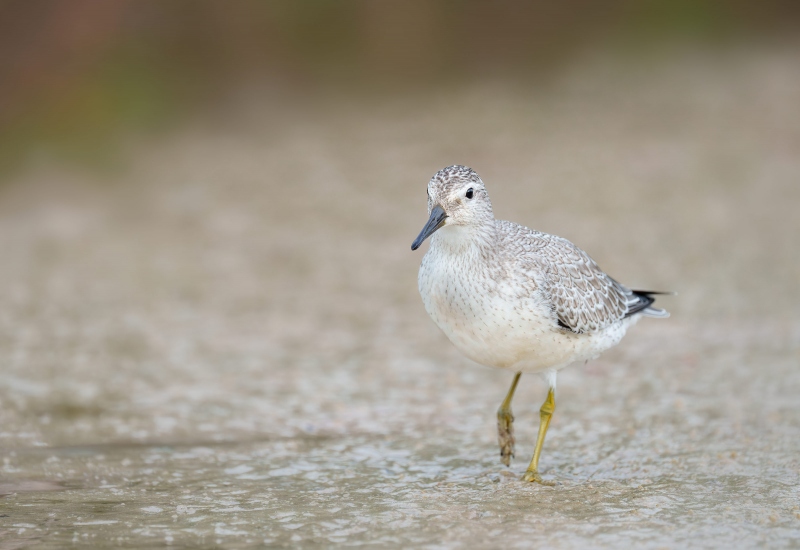
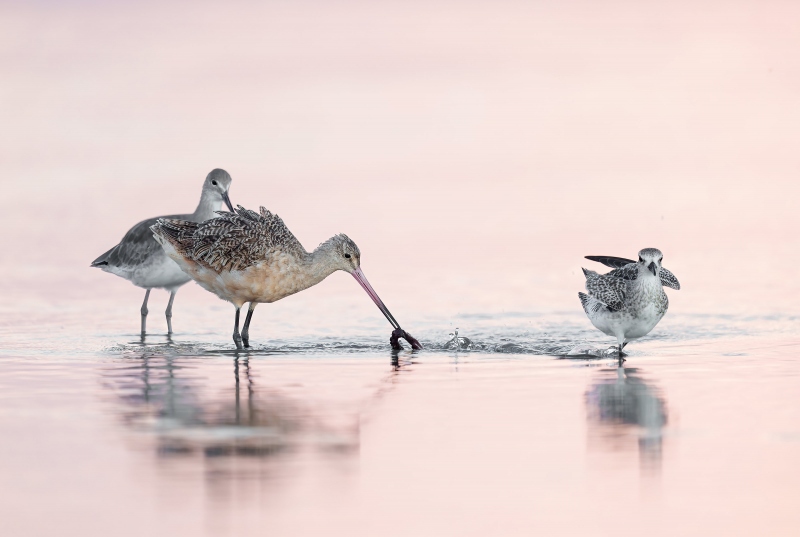
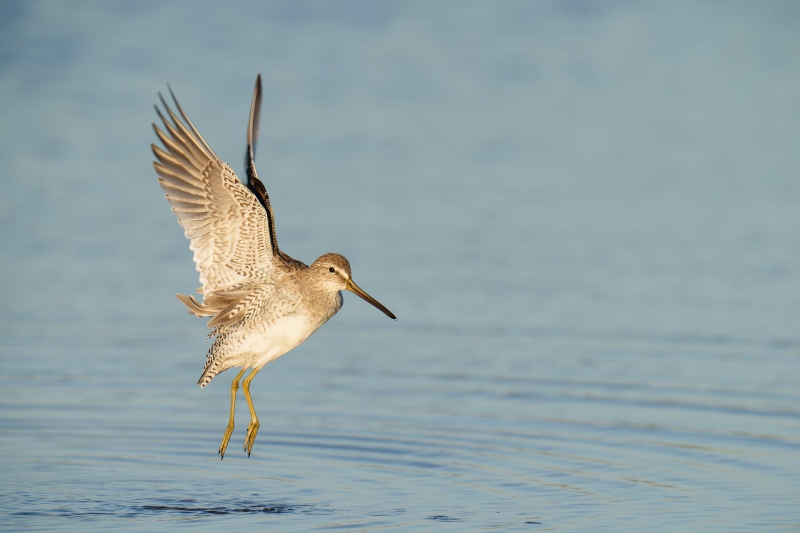
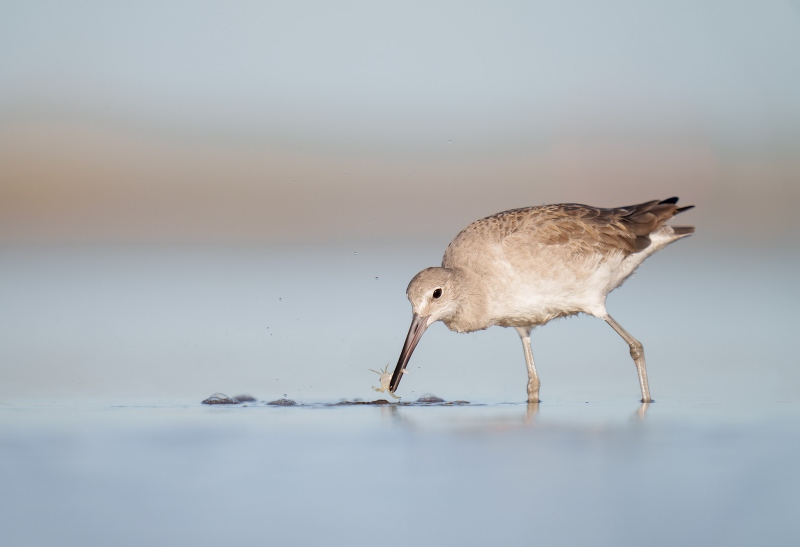
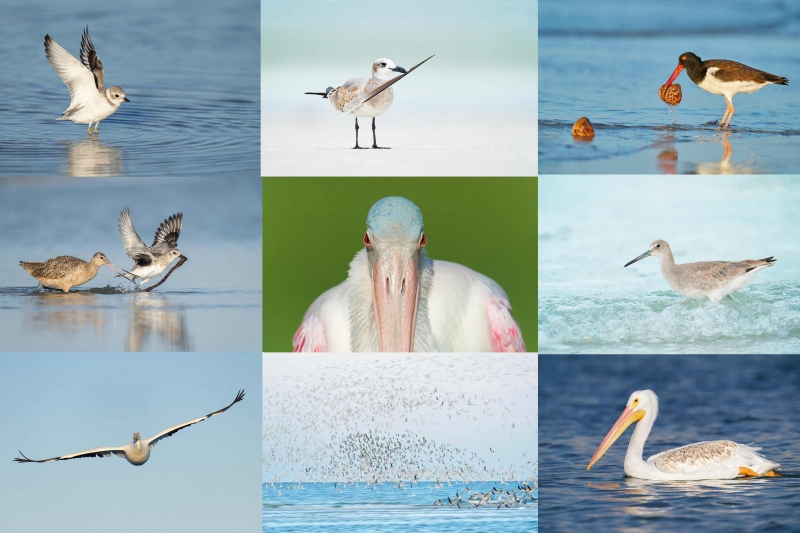














Love #4. The oft overlooked willet is a favorite of mine. Great predation shot.
All 4 images of Red Knot and Marbled Godwit and Kleptoparasitic shorebirds and Dowitcher flapping and Willet subduing fiddler crab are all well made and interesting.